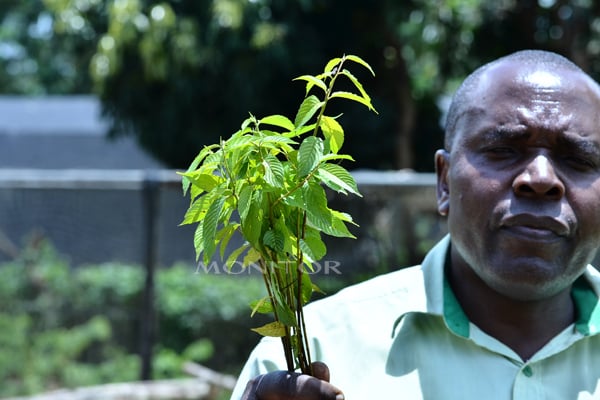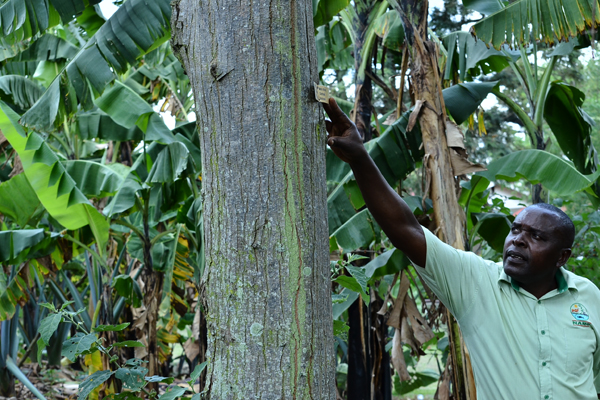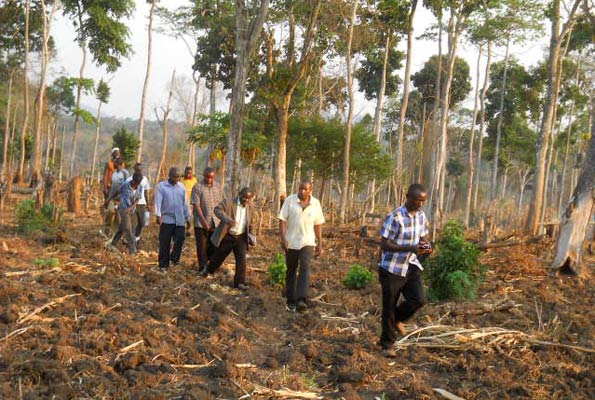Prime
Musizi, Giant Lira raise potential of commercial tree planting

A scientist at NaFORRI with musizi tree seedlings. Photos / George Katongole
What you need to know:
- Forest experts say that planting fast growing indigenous trees could add significant forest cover while potentially offering even bigger commercial rewards. Researchers look at musizi and Giant Lira as alternatives to pine and eucalyptus with emphasis on site requirements and timber end uses.
The world is in a serious need of trees. Most of the indigenous trees have been logged to pave way for agricultural activities and industrialisation leading to serious dangers of climate change. But scientists believe this can sustainably be managed.
Experts at the National Forest Resources Research Institute (NaFORRI) in Mukono District explain that through agroforestry and plantation farming, agriculture, which is the biggest culprit of forest degradation, can play its part in restoring forest cover.
According to Uganda’s Forest Reference Level submitted in 2017, deforestation in Uganda is occurring at a rate of 50,147 hectares annually. If this rate continues unabated, most of the forested area of Uganda will disappear within the coming century.
During the celebrations to mark the International forests day at their station in Kabembe on Mukono-Kayunga road, Dr Hilary Agaba, the director NaFORRI, noted that sustainable forest management and restoration is an important element owing to the climate crisis. The International Forest Day was established on March 21 by the United Nations to raise awareness of the importance of forests.
NaFORRI, an institute under the National Agricultural Research Organisation (Naro), is mandated to conduct research on all aspects of forestry including agroforestry, forest conservation and management, sustainable usage as well introduction of new tree species. “In the wake of deforestation, it is time to wake up and concentrate on efforts that really work on restoring the forest degradation in Uganda,” Dr Agaba says.
He adds that forest cover has been declining, losing up from 24 percent in the 1990s to about eight percent mainly through agriculture, encroachment, increasing urbanisation, and the construction industry. Recent forest restoration efforts have been put on pine and eucalyptus but Dr Agaba says research has proven that planting musizi (Maesopsis eminii) and Giant Lira (Melia Azedarach) trees can be more rewarding. Eucalyptus and pine offer hardwood growing opportunities for farmers. “But we are focusing on musizi and Giant Lira as they have shown more promise. These trees do well in most areas,” Dr Agaba says.
He says that fast growing hardwoods are suitable for older foresters who may not want to wait years before they get the benefit. “Giant Lira, for instance, has performed well even in dry areas as it can cope with dry conditions,” he says.
Musizi
Musizi has traditionally been grown in Uganda since the 1960s but has been degraded by thieves. Some farmers still plant it as a shade for crops such as coffee and cocoa.
Because of its invasive nature, it offers degraded forest land an opportunity to replenish.
“But the potential of musizi is big,” Dr Isaac Kiyingi, the programme leader for forest conservation and management at NaFORRI, says.
The primary use is its timber which easily saws and dries. Although it does not perform well in dry areas, it can tolerate some drought.

A scientist at NaFORRI with musizi tree seedlings.
Dr Kiyingi explains that even though there are no genetically improved seed varieties, farmers must obtain seedlings from approved tree nurseries where mother trees with superior characteristics are selected.
How to plant Musizi
When used under agroforestry, he says that large spacing needs to be adopted of at least 6x6 metres. In a plantation setting, he says, a spacing of 4x4 metres is recommended.
Common management practices include weeding in the early days of the tree while planting low agricultural crops such as beans between the rows.
To improve the stem form, musizi must be planted in an open position as it tends to move towards the sunlight.
Pruning
Typically, thinning is recommended after the fourth and eighth year to limit competition.
When large branches grow, farmers are advised to prune in order to allow clean lower stems.
Although the tree can be logged between 15-25 years, by 10 years it has a stem big enough for harvesting.
Musizi can grow up to a height of 10-30metres tall and a clear bole of up to 10 metres. Dr Kiyingi explains that the size of the tree largely depends on the site conditions and management practices.
Giant Lira
Melia volkensii also known locally as Giant Lira, a member of the mahogany family, is a fast maturing hardwood tree — dubbed the mahogany of the drylands. It has multiple uses and its timber is in high demand.
The Melia species found in Uganda is called Melia Azedarach, while the one that grows in Kenya is Melia Volkensii, also called mukau.
Dr Kiyingi compares the timber from that Giant Lira to that of true Mahogany.
“Because of its high quality wood, its prices are high compared to eucalyptus and pine trees,” Dr Kiyingi says.
He says that the wood from Giant Lira is durable while the trees are termite-resistant. The tree has been successfully planted in dry areas such as Karamoja.
Giant Lira has generated a lot of enthusiasm amongst tree farmers as it also provides high quality leaf fodder for animals, firewood fuel while its purple flowers are good for bee forage.
Advantages planting trees
Dr Kiyingi says that farmers can easily grow the Giant Lira for both woodlots, boundary planting and agroforestry.
Its sturdy nature is helpful for farmers as the trees act as windbreakers when inter-cropped. The best intercrops include cereals such as peas, green grams and cowpeas.
Dr Kiyingi explains that the tree can be planted at a spacing of 3x3 metres under plantation setting while plants should be thinned at two to three years to remove the crooked and small trees while increasing the space.
The tree grows faster and matures in about eight years, so the profits have potential to be bigger.
Common management practices include “topping” the tree, which means cutting its crown at a height of four to five metres, resulting in faster “fattening” of the stem.
Commercial lifetime for producing such trees with a girth of about 40-50cm and a clean straight bole of five to six metres in diametre is estimated at a maximum of 15 years. But with proper management, trees can be ready after less than 10 years.
Giant Lira: Quick facts
It is a deciduous tree with an open, spreading crown; usually growing 6 - 20 metres tall. The bole is around 25cm in diameter. The tree is mainly planted for its coarse-textured timber, which is durable- comparable to true mahogany and extremely termite and decay resistant. The wood is easily worked and is valued locally for making items such as door and window frames, door shutters, rafters, poles and furniture, log hives and acoustic drums. Source: SPGS
Musizi: Site and growth requirements
• Requires moderately fertile, deep and well- drained soils.
• It needs Mean Annual Rainfall of more than 1200mm and altitudes 1200m above sea level.
• No improved/quality seed available yet.
• 625 seedlings can be planted in one hectare.
• Does not tolerate stony, compacted or water-logged soils
• It is fire-sensitive
• Planted closely to secure long straight butt logs.
• Can be harvested for saw logs at 15 to 20 years.
Source: SPGS




